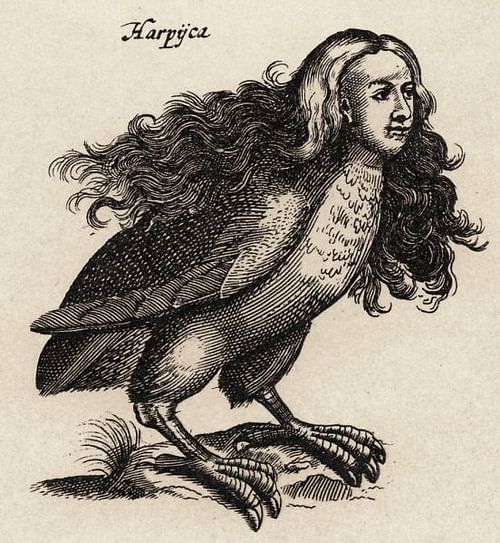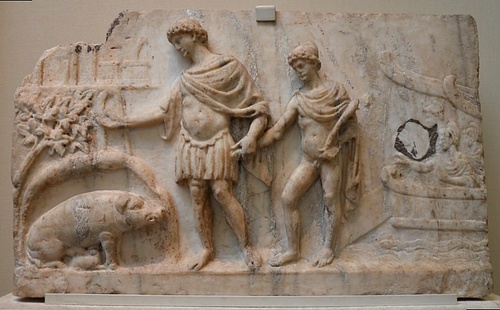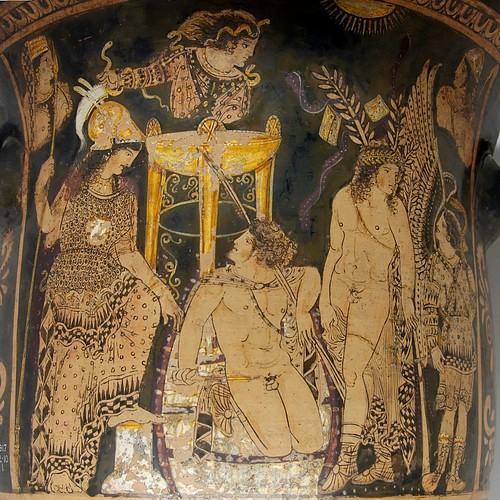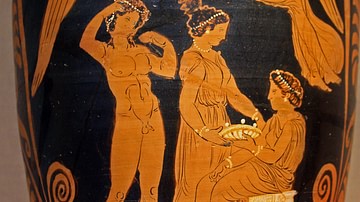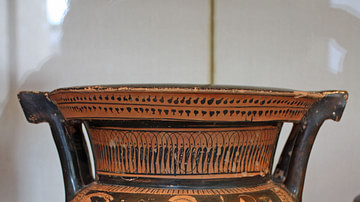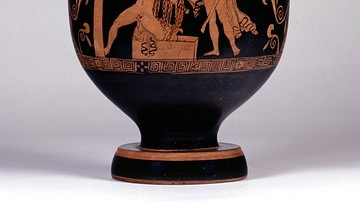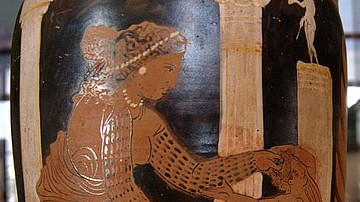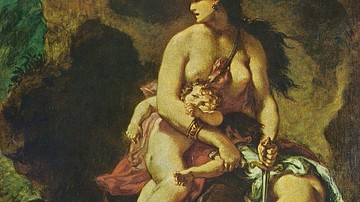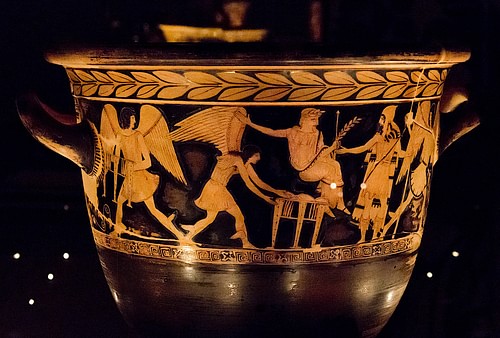
A harpy, also known as a harpyia (pl. harpyiai), is a part-bird, part-woman monster in Greek mythology. Known as the 'Hounds of Zeus,' they were the personification of storm winds and were under the command of Zeus, who would send them out during storms to do his bidding. If a person or object went missing, it would be blamed on the harpies.
In some accounts, there are dozens of harpies, while in others, there are between one and four of them. For example, Hesiod (c. 700 BCE) mentions two harpies by name in his Theogony: Aello (rainstorm) and Okypete (swift-flier), while Homer (c. 750 BCE) mentions one by name: Podarge (light-foot) in the Odyssey. In his Aeneid, the Roman poet Virgil (70-19 BCE) introduces us to a fourth harpy, Celaeno (storm cloud).
Genealogy
According to Hesiod in his Theogony, the harpies are daughters of Thaumas (the son of the earth goddess Gaia) and of the Oceanid Electra. They are also sisters of Iris, the personification of the rainbow and a messenger of the Olympian gods.
And Thaumas took Electra for his bride,
Deep-flowing Ocean's daughter, and she bore
Swift Iris and the Harpies; lovely-haired
Aello and Okypete, who fly
On their swift wings as fast as birds, or breath
Of wind; high through the air they hurl themselves.(Theogony, 263-269)
In some sources, they are mentioned as being the daughters of Oceanus and Terra, while the Roman poet, Gaius Valerius Flaccus (c. 45-90 CE), states that they were the daughters of the monster Typhoeus in his epic poem the Argonautica.
Appearance & Depictions
In earlier accounts, the harpies were described as beautiful young women with wings, who were the personification of windy or stormy weather. Over time, they have developed into the hideous creatures that we know them as today. They are described as having long, fair hair and the face and upper body of a woman, but the tails, legs, claws and wings of a bird of prey. They were horrible to look at and whatever they touched gave off a horrendous smell. In the stories of Jason and Argonauts, the harpies were depicted as bird-like creatures with bodies like vultures, ears like bears, and a woman's face. In the Aeneid, the harpies' description is written as the following:
With virgin faces, but with wombs obscene,
Foul paunches, and with ordure still unclean;
With claws for hands, and looks for ever lean.(Aeneid, 3.282-284)
Depictions of the harpies in art can be found on ancient Greek vases and in temple carvings. Their fearsome appearance and aggressive nature have also inspired the works of French illustrator Gustav Doré (1832-1883) and the British Pre-Raphaelite painter Evelyn de Morgan (c. 1850-1919).
Role in Mythology
In the ancient Greek world, the harpies were sent by the gods, namely Zeus, Hera and Athena, to punish people who had angered the gods. They were under the dominion of Zeus and were often referred to as the "Hounds of Zeus." The harpies were seen as being bad luck as they could come out of nowhere, steal, destroy property, and wreak havoc on people's lives. They were always ravenous and would steal food or eat their victims before carrying them away. If a person or object suddenly disappeared into thin air, the common conclusion would be that a harpy had carried them off in their sharp talons.
The Harpies & King Phineus
The myth most famously associated with the harpies is the tale of King Phineus. King Phineus was the king of Thrace who had offended the gods. In the most famous version of the myth, he had remarried after his first wife had died, and in his eagerness to make his new bride happy, he allowed her to torture his children. In other versions, King Phineus was given the gift of prophecy but infuriated the gods by revealing too many of their plans. As punishment, Phineus was blinded, and the gods sent the harpies to torment him. The harpies refused to let him eat by constantly snatching his food or spoiling it with their foul stench. As a result, Phineus never got enough to eat and started wasting away.
He was finally saved by Jason and the Argonauts, who had stopped over in Thrace during their journey to collect the Golden Fleece. Two of the Argonauts, Calais and Zetes, the brothers of Phineus' first wife, wanted to kill the harpies, but their sister, Iris, persuaded the Argonauts to spare them if they promised to keep away from King Phineus. The harpies were then driven off to the Strophades Islands (islands in the Ionian Sea).
The Harpies & Aeneas
Aeneas was a Trojan hero and the son of the goddess Aphrodite. After the Trojan War ended and Troy was destroyed, Aeneas received a prophecy that he would found a great city (Rome). He travelled far and wide, ending up in the Strophades Islands, where the harpies were living at the time. Aeneas and his men hunted some goats and cattle for food, but as they sat down to enjoy their feast, the harpies swooped down, grabbed their food, and spread their stinking filth:
We feed with hunger, and the bowls go round;
When from the mountain-tops, with hideous cry,
And clatt'ring wings, the hungry Harpies fly;
They snatch the meat, defiling all they find,
And, parting, leave a loathsome stench behind.(Aeneid, 3.292-296)
Aeneas and his men moved to another spot, but the same thing happened. Aeneas ordered his men to fight the harpies, but their weapons could not harm them. Celaeno, the leader of the harpies, told the men that they would suffer terrible hunger for trying to kill her and her sisters and would not be able to found a city until they had grown so hungry that they had eaten their tables. After Aeneas and his men had arrived in Italy, they became so hungry that they began to eat the bread platters that they had been served a meal on. They realised that these platters were the "tables" that Celaeno had spoken about.
Podarge & Her Children
The harpy Podarge lay with the West Wind, Zephyrus, and bore the magical and immortal horses Xanthus and Balius. Xanthus and Balius ran like the wind and pulled the chariot of Achilles during the Trojan War.
The gods gave the magical horses as a wedding gift to Peleus, king of the Myrmidons of Thessaly and a hero in Greek mythology, when he married the sea goddess Thetis. The horses were then given to their son Achilles when he went to fight in Troy.
Now the war-team.
Patroclus ordered Automedon to yoke them quickly -
a man he honoured next to Achilles breaker of men,
always firmest in battle, nerved to wait the call.
So at his command Automedon yoked the horses,
the rapid stallions Roan Beauty and Dapple,
the team that raced the gales, magnificent team
the storm-wind filly Lightfoot foaled for the West Wind,
grazing the lush green grass along the Ocean's tides.(Iliad, 16.148-156)
Harpies & Furies
Throughout mythology, there are rich examples of the connections between supernatural creatures. For instance, in Greek mythology, there were various connections made between the harpies and the Furies, which can be seen in the myth of Pandareus in Homer's Odyssey. Pandareus had been turned into stone by Zeus as punishment for stealing his golden dog. He left behind two daughters, who were cared for by Aphrodite. Aphrodite had even managed to find them husbands, and they were getting ready for their wedding day when the harpies came and took them away to be slaves to the Furies.
But then, when Aphrodite approached Olympus' peaks
to ask for the girls their crowning day as brides
from Zeus who loves the lightning - Zeus who knows all,
all that's fated, all not fated, for mortal man-
then the storm spirits snatched them away
And passed them on to the hateful Furies,
yes, for all their loving care.(Odyssey, 20.73-79)
In the Aeneid, Virgil states that when the harpy Celaeno threatened Aeneas and his men, she referred to herself as Furiarum maxima (the eldest of the Furies). The connection between the harpies and the Furies is based on the perception the ancient Greeks had of them; people were afraid of them and their power, and therefore they were viewed in the same light.
In Modern Day
Today, the term 'harpy' can sometimes be used to describe a mean, heartless woman. However, the harpies can also be viewed as strong female characters who represent male fears about female power and who are ultimately a symbol of the feminist movement.
Harpies are associated with both vultures and eagles, lending their name to one of the largest and most awe-inspiring eagle species, the harpy eagle. Much like the mythological harpies, the harpy eagle swoops down, seemingly out of thin air, to snatch up its prey in its talons.
A creature resembling a harpy can also be seen on the coat of arms of the European principality, Liechtenstein, where the half-woman, half-bird creature is referred to as a 'virgin eagle.'


